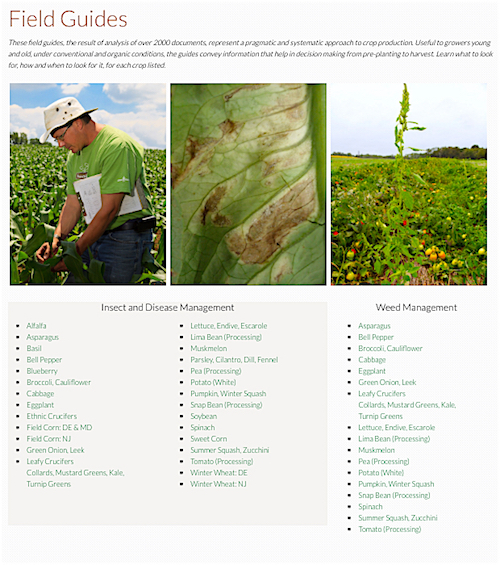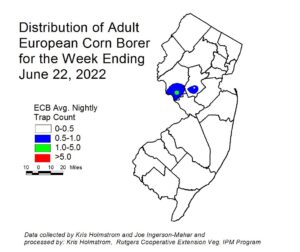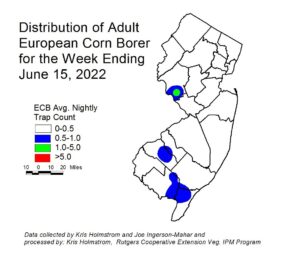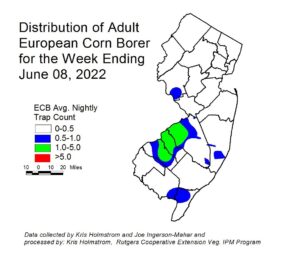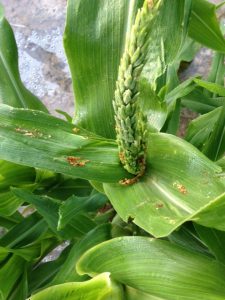Sweet Corn
Low numbers of European corn borer (ECB) moths remain a sporadic, low component of blacklight trap catches. Feeding in whorl and pre-tassel stage is now less common, as control has been applied to infested plantings and later blocks (now in whorl stage) have avoided most of the egg laying period. Slightly higher adult activity is in scattered pockets around the state (see map below at right). ECB injury over the threshold of 12% of plants infested, while still around, has generally been declining over this past week. We expect feeding wind down over the next week or so as we move into the period between generations.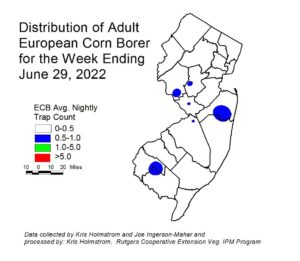
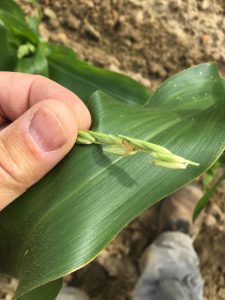 Look for the characteristic “shot-hole” type of feeding (photo below at right) and consider treating when infested plants exceed 12% in a 50 plant sample. As plantings proceed to the pre-tassel stage, ECB larvae may be found in emerging tassels (see photo at left). It is a good idea to treat individual plantings as they move into the full tassel/first silk stage one time. This eliminates any ECB larvae that have emerged with the tassels as they begin to move down the stalk to re-enter near developing ears.
Look for the characteristic “shot-hole” type of feeding (photo below at right) and consider treating when infested plants exceed 12% in a 50 plant sample. As plantings proceed to the pre-tassel stage, ECB larvae may be found in emerging tassels (see photo at left). It is a good idea to treat individual plantings as they move into the full tassel/first silk stage one time. This eliminates any ECB larvae that have emerged with the tassels as they begin to move down the stalk to re-enter near developing ears.
Useful insecticides for this particular application include synthetic 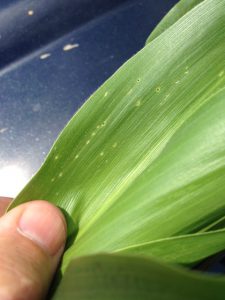 pyrethroids (IRAC Grp 3), spinosyns (including OMRI approved Entrust) IRAC Grp 5), and diamides such as Coragen or Vantacor (IRAC Grp 28) or materials such as Besiege which include the active ingredient in Coragen. Synthetic pyrethroids alone should NOT be used for corn earworm (CEW) protection on silking corn. Control with these materials is very inconsistent.
pyrethroids (IRAC Grp 3), spinosyns (including OMRI approved Entrust) IRAC Grp 5), and diamides such as Coragen or Vantacor (IRAC Grp 28) or materials such as Besiege which include the active ingredient in Coragen. Synthetic pyrethroids alone should NOT be used for corn earworm (CEW) protection on silking corn. Control with these materials is very inconsistent.
The highest nightly trap catches of ECB for the week ending 6/29/22 are as follows:
| Bellemeade 1 | Farmingdale 1 | Morristown 1 |
| Blairstown 1 | Georgetown 1 | New Egypt 1 |
| Centerton 1 | Lawrenceville 1 | Princeton 1 |
| Crosswicks 1 | Matawan 1 | Sergeantsville 1 |
 Articles in this section contain information helpful to the NJ commercial organic grower.
Articles in this section contain information helpful to the NJ commercial organic grower.